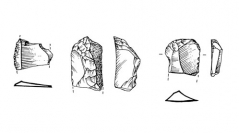

 Comptes Rendus Palevol
5 (1-2) - Pages 193-202
Comptes Rendus Palevol
5 (1-2) - Pages 193-202To a Mousterian rich of scrapers and denticulates, characterized by a cold stage of the isotopic level 4, succeeds without relationship, in Liguria and Provence, the Protoaurignacian with Dufour bladelets. This allochtonous facies appears during the Wurmian interpleniglacial period (isotopic level 3). This cultural facies, first complex of the North-Mediterranean Upper Palaeolithic, is the fact of Modern Men issued from the East. In Venetia, towards 40000 BP, these Modern Men supplant autochtonous Mousterian groups of the Western zone. At the same period, in a parallel direction, by the Danubian way, an other flow of settlement, more inner and earlier, has reached the centre of Europe, and will be to the origin of the typical Aurignacian of the western Europe. In Liguria, we find again the Protoaurignacian at the Mochi shelter (37000 BP). This Mediterranean flow of Modern Men diffuses rapidly because, between 35000 and 34000 BP, we find it in Provence, Languedoc and Ardèche. Later, in Liguria, the typical Aurignacian succeeds to the initial cultural facies at the last pleniglacial event (isotopic level 2).
Homo sapiens, Early Upper Paleolithic, Protoaurignacian, Provence–Liguria